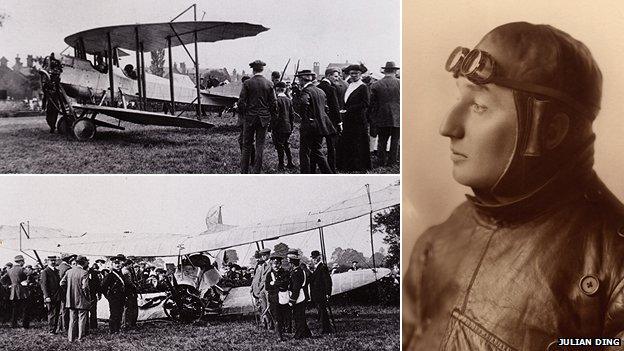War at Home: William Ding's life and death as a test pilot
- Published

W Rowland Ding survived a number of crashes on his way to becoming a celebrity in Yorkshire
Hundreds of people saw the moment of tragedy, as one delicate wing of the aeroplane flown by celebrity test pilot William Rowland Ding broke away and sent it spiralling to the ground.
For hundreds of feet it fell before crashing, less than a mile from the crowds at Soldier's Field at Roundhay Park in Leeds.
"He would have been playing to the crowds and on this occasion he rolled the dice and failed," says Ding's grandson, Julian Ding.
Not just a pilot, Ding was a showman, a hearthrob and a hero to school children described by his grandson as a "Victorian adrenaline junkie".
Ian Reed, director of the Yorkshire Air Museum, said: "Being a test pilot was inherently dangerous because it was all new.
"People were just finding out what aircraft - and the materials they were made with - could do.
"Because of the low power of the engines - about 100 horsepower, roughly the same as a modern hatchback car - they had to be built light, and that means fragile."
Originally an engineer, Ding was 28 when he gained his pilot's licence after just three hours practice.
His first taste of the limelight came in late May 1914 when he was hired by the indomitable Princess Ludwig of Lowenstein-Wertheim to get her across the channel faster than steamers could manage.
Ding flew his own aircraft - the White Falcon - from Roundhay Park and over Leeds
"It will be recalled," industry paper Flight archly noted at the time. "That Mr Ding only obtained his pilot's certificate on April 28th, and these were his first long cross-country flights."
His appetite for flying saw him rapidly clock up 35,000 hours in the cockpit. He bought an aircraft building company, the Northern Aircraft Co, and tales of his exploits and accidents appeared in print.
'Equivalent of astronauts'
Eric Sudell was a fan of Ding and collected parts of the crashed plane
Julian Ding said: "It was cutting edge technology to them. It's difficult to imagine it now because to us it seems like so long ago and rather archaic but it was so exciting to them.
"This was the equivalent of astronauts today - they were witnessing a space shuttle take off."
Ding took a job as a test pilot at Blackburn's, a leading aircraft maker based on Roundhay Road, Leeds, a site now occupied by a Tesco store.
He built a reputation for having flown more types of aircraft than anyone else in England. White Falcon, his personal machine made from factory spares and flown from Roundhay Park, became a familiar sight over Leeds.
While the war had focussed minds, aircraft were still built by private companies and both bosses and employees had to have an eye for moneymaking opportunities.
Julian said: "He wrote his name, in big, bold, black letters on the underside of his wing so that no one was in any doubt who was flying the plane above them."
Postcards of Ding sold widely and personal appearances at events like Northallerton Carnival drew large crowds.
But his passion for thrilling the crowds caught up with him one warm afternoon in May 1917.
'Belief of invulnerability'
A series of loops - a speciality of one of Ding's rivals - put too much strain on the wings, which collapsed.
Julian said: "But there is almost an inevitability to these sort of people, taking risks and taking that one risk too far and it costing them their lives.
"Bearing in mind he had crashed several times before this incident and I do get the sense that there is almost a belief of invulnerability with that type of person.
"I get a very real sense he was the Victorian equivalent of an adrenaline junkie."
The inquest heard the plane involved, a Be2c, was known for its stability and tests in no way required it to be looped. A verdict of accidental death was recorded.
Among the swarms of adoring fans was seven-year-old Eric Sudell. His grandson, Matthew Ridley, said: "Everyday after school my grandfather would be up [at Roundhay park] with all his classmates.
"They would all be crowding round the aircraft, looking up at him, saying 'Will you take me up Mr Ding?' and he would say 'Well, maybe when you are a little older'.
"On the day of the crash my grandfather was at Hill Top Mount about a mile and a half away and they were watching him and they saw him loop and my grandfather said as he got to the top of the second loop the wing collapsed and down he went."
The crash site, off Oakwood Grange Lane, is still recognisable.
Julian Ding standing by railings possibly damaged by the falling plane
Ding's body was laid in the drive of a nearby house, which is now a care home
Mr Ridley said: "[The children] came down the next day and the wing was still in the road and the nose was buried in a nearby patch of trees with the tail sticking up in the air.
"Mentioned in the [inquest] account is an iron paling and still there is a fairly ancient iron railing, which could well be the one talked about in the report.
"It sustained some damage [from the crash] - and the one remaining at the site has some twists and turns which might be a relic of the impact."
Julian said: "I'm just sad I never met my grandfather and I only got to know him through books.
"But I'm glad to find these places and glad to know his story."
In 2007, Eric Sudell revisited the crash site and left flowers. The note he attached read: "Take me up with you Mr Ding. May you rest in peace."
- Published27 November 2013